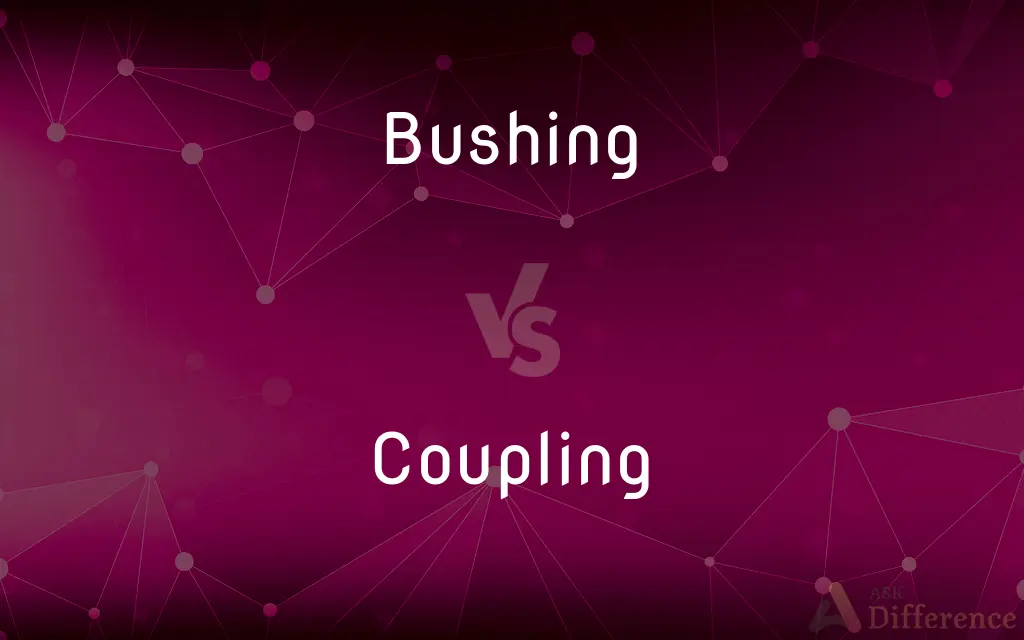Bushing vs. Coupling — What's the Difference?
Edited by Tayyaba Rehman — By Urooj Arif — Updated on March 17, 2024
Bushing provides an interface between two parts, often reducing friction or wear, whereas coupling connects two shafts for power transmission.

Difference Between Bushing and Coupling
Table of Contents
ADVERTISEMENT
Key Differences
Bushing is primarily used to reduce the wear and friction between mechanical parts and to support shafts. It is often designed to fit snugly into a housing or bore, providing a smooth surface for a rotating shaft. Coupling, on the other hand, is designed to connect two shafts together, allowing for the transmission of power from one shaft to the other. It compensates for misalignment and can reduce shock loads.
Bushing materials vary widely, from bronze and plastic to rubber, depending on the application's needs for durability, flexibility, and conductivity. Coupling materials also vary, including steel, aluminum, and polymers, chosen based on the required strength, flexibility, and environmental resistance.
The installation of a bushing often involves pressing it into a housing or bore, where it then provides a wear-resistant, smooth surface for a shaft to rotate within. Coupling installation usually involves securing each shaft end into the coupling, which might require setscrews, clamps, or a keyed interface for a secure fit.
Maintenance considerations for bushings include regular inspection for wear and lubrication to ensure longevity. Couplings may require alignment checks and adjustments, as well as lubrication, depending on the type of coupling used.
In terms of applications, bushings are found in a wide array of machinery, from automotive engines to industrial equipment, serving mainly to reduce wear and isolate vibration. Couplings are critical in applications that require the transfer of rotary motion between two shafts, such as in motors and pumps, where alignment and torque transmission are key.
ADVERTISEMENT
Comparison Chart
Function
Reduces friction, supports shafts
Connects two shafts, transmits power
Material
Bronze, plastic, rubber
Steel, aluminum, polymers
Installation
Pressed into housing or bore
Secured to shaft ends
Maintenance
Inspection for wear, lubrication
Alignment checks, lubrication (if applicable)
Application Examples
Automotive engines, industrial machines
Motors, pumps, industrial drives
Compare with Definitions
Bushing
A cylindrical lining designed to reduce wear or friction between mechanical parts.
The sleeve bushing in the motor assembly prolongs the equipment's lifespan.
Coupling
Connects two shafts in a line, allowing for no flexibility.
The rigid coupling was used in the machine to maintain precise alignment between the shafts.
Bushing
A bushing designed with a spring mechanism to absorb shocks and vibrations.
Spring bushings in the suspension system improve ride quality by dampening road bumps.
Coupling
Allows for connection of shafts that are inclined to each other.
The universal coupling was crucial for the drive system's angular misalignments.
Bushing
Used to fit together parts of different sizes, typically pipes.
The reducer bushing allowed us to connect the two pipes of varying diameters.
Coupling
Transmits torque between two shafts via interlocking gears.
The gear coupling in the drive system allows for high torque transmission with minimal slippage.
Bushing
A bushing with a flange at one end to prevent it from moving through a bore.
The flanged bushing was used to securely position the shaft within the machine.
Coupling
Accommodates misalignments between shafts while transmitting power.
A flexible coupling was necessary to deal with the slight misalignment in the pump system.
Bushing
Prevents electrical conduction between two parts while allowing mechanical movement.
Insulating bushings are crucial in electric motors to prevent short circuits.
Coupling
Uses hydraulic fluid to transmit power between two shafts.
The fluid coupling provided a smooth start-up and protection from mechanical shocks.
Bushing
A fixed or removable cylindrical metal lining used to constrain, guide, or reduce friction.
Coupling
A coupling is a device used to connect two shafts together at their ends for the purpose of transmitting power. The primary purpose of couplings is to join two pieces of rotating equipment while permitting some degree of misalignment or end movement or both.
Bushing
(Electricity) An insulating lining for an aperture through which a conductor passes.
Coupling
The act of linking together or forming couples.
Bushing
An adapter threaded to permit joining of pipes with different diameters.
Coupling
A device that links or connects.
Bushing
(mechanical engineering) A type of bearing, a cylindrical lining designed to reduce friction and wear inside a hole, often used as a casing for a shaft, pin or hinge.
Coupling
(Electronics) The transfer of electricity from one circuit to another.
Bushing
(mechanical engineering) An elastic bearing used as a type of vibration isolator, commonly made of rubber. An interface between two parts, damping the movement and the energy transmitted.
Coupling
(Chemistry) Facilitation or acceleration of one chemical process due to the presence or action of another.
Bushing
(mechanical engineering) A threaded bushing: a fastener element that is inserted into an object, usually to add a threaded hole in a softer or thin material.
Coupling
The body part of a four-footed animal that connects the hindquarters to the forequarters.
Bushing
(electrical engineering) A lining for an opening through which a conductor passes, providing insulation and mechanical protection for the conductor.
Coupling
Act of joining together to form a couple.
Bushing
An adapter for joining pipes of different size.
Coupling
A device that couples two things together.
Bushing
Present participle of bush
Coupling
(software engineering) The degree of reliance between two or more software modules.
Bushing
The operation of fitting bushes, or linings, into holes or places where wear is to be received, or friction diminished, as pivot holes, etc.
Coupling
(electronics) A connection between two electronic circuits such that a signal can pass between them.
Bushing
A bush or lining; - sometimes called a thimble. See 4th Bush.
Coupling
(physics) The property of physical systems that they are interacting with each other
Bushing
An insulating liner in an opening through which conductors pass
Coupling
Present participle of couple
Bushing
A cylindrical metal lining used to reduce friction
Coupling
A device or contrivance which serves to couple or connect adjacent parts or objects; as, a belt coupling, which connects the ends of a belt; a car coupling, which connects the cars in a train; a shaft coupling, which connects the ends of shafts.
Coupling
A connection (like a clamp or vise) between two things so they move together
Coupling
A mechanical device that serves to connect the ends of adjacent objects
Coupling
The act of pairing a male and female for reproductive purposes;
The casual couplings of adolescents
The mating of some species occurs only in the spring
Common Curiosities
Are couplings available that can adjust for shaft misalignment?
Yes, flexible couplings are designed to handle misalignment.
What is the primary purpose of a bushing?
To reduce wear and friction, and to support shafts.
Is regular maintenance required for bushings and couplings?
Yes, including lubrication and inspection for wear or misalignment.
How do you install a bushing?
By pressing it into a housing or bore.
Can bushings be used to reduce noise in machinery?
Yes, by reducing vibration and providing a smooth interface.
What material is commonly used for making bushings?
Bronze, plastic, and rubber, among others.
What is the advantage of using an insulating bushing in electrical applications?
To prevent electrical conduction while allowing mechanical movement.
How does a universal coupling accommodate shaft alignment?
By allowing connection of shafts at an angle.
How does a coupling differ from a bushing in function?
Couplings connect two shafts for power transmission, whereas bushings reduce friction.
What applications typically use couplings?
Motors, pumps, and industrial drives.
How does a flanged bushing differ from a sleeve bushing?
A flanged bushing has a flange at one end to prevent movement.
What is a key feature of a gear coupling?
It transmits torque via interlocking gears.
Why would a spring bushing be used in a suspension system?
To absorb shocks and improve ride quality.
Can couplings transmit power without physical contact?
Yes, fluid couplings transmit power through hydraulic fluid.
Why might a reducer bushing be necessary in a piping system?
To connect pipes of different diameters.
Share Your Discovery

Previous Comparison
Ma vs. Mom
Next Comparison
Kibitka vs. TentAuthor Spotlight
Written by
Urooj ArifUrooj is a skilled content writer at Ask Difference, known for her exceptional ability to simplify complex topics into engaging and informative content. With a passion for research and a flair for clear, concise writing, she consistently delivers articles that resonate with our diverse audience.
Edited by
Tayyaba RehmanTayyaba Rehman is a distinguished writer, currently serving as a primary contributor to askdifference.com. As a researcher in semantics and etymology, Tayyaba's passion for the complexity of languages and their distinctions has found a perfect home on the platform. Tayyaba delves into the intricacies of language, distinguishing between commonly confused words and phrases, thereby providing clarity for readers worldwide.















































